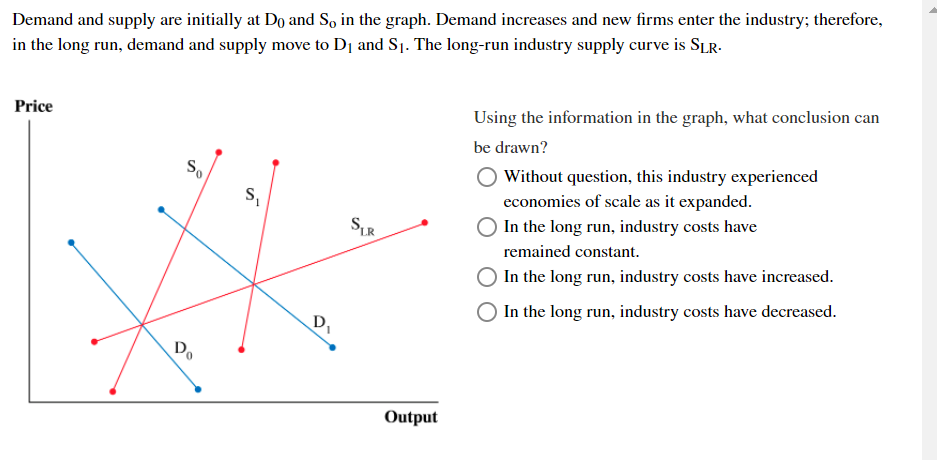Demand and supply are initially at Do and S, in the graph. Demand increases and new firms enter the industry; therefore, in the long run, demand and supply move to D¡ and S1. The long-run industry supply curve is SLR. Price Using the information in the graph, what conclusion can be drawn? Without question, this industry experienced economies of scale as it expanded. So S, S. In the long run, industry costs have remained constant. In the long run, industry costs have increased. In the long run, industry costs have decreased. D, D Output
Demand and supply are initially at Do and S, in the graph. Demand increases and new firms enter the industry; therefore, in the long run, demand and supply move to D¡ and S1. The long-run industry supply curve is SLR. Price Using the information in the graph, what conclusion can be drawn? Without question, this industry experienced economies of scale as it expanded. So S, S. In the long run, industry costs have remained constant. In the long run, industry costs have increased. In the long run, industry costs have decreased. D, D Output
Managerial Economics: Applications, Strategies and Tactics (MindTap Course List)
14th Edition
ISBN:9781305506381
Author:James R. McGuigan, R. Charles Moyer, Frederick H.deB. Harris
Publisher:James R. McGuigan, R. Charles Moyer, Frederick H.deB. Harris
Chapter10: Prices, Output, And Strategy: Pure And Monopolistic Competition
Section: Chapter Questions
Problem 6E
Related questions
Question
I do not understand how to answer this question can you please explain the question in a better revelant form to understand better?

Transcribed Image Text:Demand and supply are initially at Do and S, in the graph. Demand increases and new firms enter the industry; therefore,
in the long run, demand and supply move to D¡ and S1. The long-run industry supply curve is SLR.
Price
Using the information in the graph, what conclusion can
be drawn?
So
S,
Without question, this industry experienced
economies of scale as it expanded.
In the long run, industry costs have
remained constant.
In the long run, industry costs have increased.
In the long run, industry costs have decreased.
D,
Do
Output
Expert Solution
This question has been solved!
Explore an expertly crafted, step-by-step solution for a thorough understanding of key concepts.
This is a popular solution!
Trending now
This is a popular solution!
Step by step
Solved in 2 steps

Knowledge Booster
Learn more about
Need a deep-dive on the concept behind this application? Look no further. Learn more about this topic, economics and related others by exploring similar questions and additional content below.Recommended textbooks for you

Managerial Economics: Applications, Strategies an…
Economics
ISBN:
9781305506381
Author:
James R. McGuigan, R. Charles Moyer, Frederick H.deB. Harris
Publisher:
Cengage Learning


Exploring Economics
Economics
ISBN:
9781544336329
Author:
Robert L. Sexton
Publisher:
SAGE Publications, Inc

Managerial Economics: Applications, Strategies an…
Economics
ISBN:
9781305506381
Author:
James R. McGuigan, R. Charles Moyer, Frederick H.deB. Harris
Publisher:
Cengage Learning


Exploring Economics
Economics
ISBN:
9781544336329
Author:
Robert L. Sexton
Publisher:
SAGE Publications, Inc

Microeconomics: Private and Public Choice (MindTa…
Economics
ISBN:
9781305506893
Author:
James D. Gwartney, Richard L. Stroup, Russell S. Sobel, David A. Macpherson
Publisher:
Cengage Learning

Economics: Private and Public Choice (MindTap Cou…
Economics
ISBN:
9781305506725
Author:
James D. Gwartney, Richard L. Stroup, Russell S. Sobel, David A. Macpherson
Publisher:
Cengage Learning